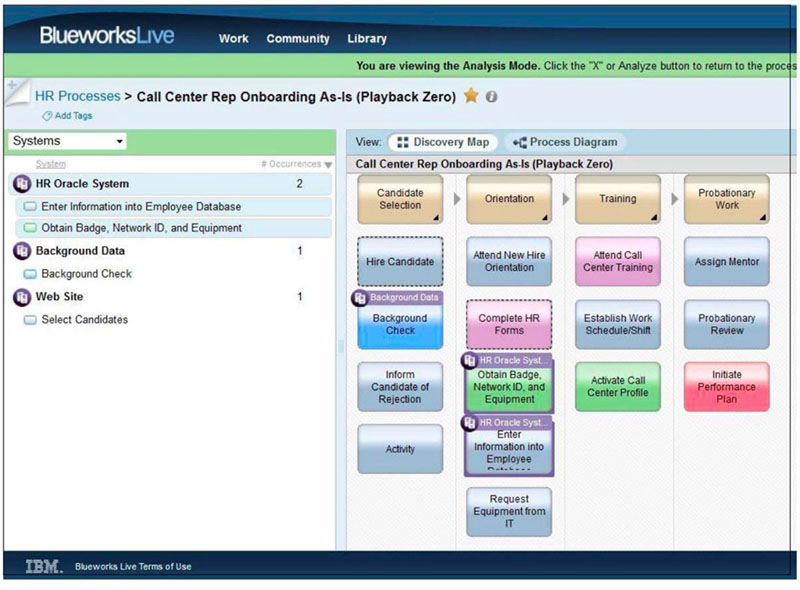Preface
We can estimate a business process project as low, medium, or high complexity within an order of magnitude. This estimate can be used to build a business case for chartering a project initiative to further document and analyze the process.
For some BPM teams, this estimate provides enough detail to support a business case and start implementation.
Characterizing the process with high-level modeling
The ROM estimate requires a high-level process model of the As-Is process. We use an early version of the Blueworks Live process model to generate a quick count of attributes that characterize the complexity of a business process or process area.

Fig. 2.4.4/1: Use the Analysis mode in Blueworks Live to gather and count processes, subprocesses, inputs/output, business entities, participants, and system integrations
The effort required to briefly identify and assess the business process through process discovery can be completed in a 2 - 3 hour workshop with the right participants. For a larger, more complex process that requires interviews with several different SMEs, it could take 2 - 3 days of workshop time to generate the level of detail required for a ROM estimate.
Estimating scope and complexity by comparing historic process characteristics
The ROM estimating method works by comparing measurable characteristics of your process to typical low, medium, and high complexity processes. Depending on how your process compares, we can characterize it as low, medium, or high complexity. Although the comparison of each metric is objective, the overall assessment of the size of your process is subjective.
Table 2.4.4/1 is based on data from hundreds of process projects aggregated by IBM over a period of nearly six years. This historic project data characterizes three deployment statistics in ranges to illustrate low, medium, and high complexity project profiles: project duration, developer hours, number of developers.
Implementation complexity Low Medium High My process Top Level Business Processes 1 1 2 1 LOW Lower Level Business Processes 5 7 10 2 LOW Process Steps/Activities 15 30 60 27 MED. Participant Groups 3 5 10 6 HIGH Coaches (Low Complexity) 10 15 20 14 MED. Coaches (Medium Complexity) 5 7 10 0 LOW Business Entities 5 15 30 6 MED. Inputs/Outputs 80 150 250 Rules/Policies (Low Complexity) 5 7 10 3 LOW Rules/Policies (Medium Complexity) 0 2 5 0 LOW Basic Reports & Scoreboards 4 6 8 2 LOW System Integrations 2 3 4 4 HIGH Implementation Duration 10 weeks 14 weeks 20 weeks 14-16 weeks Developer Hours 900-1500 1500-2500 2500-5000 2500-3000 Number of Developers 2-3 3-4 4-5 4 developers
The descriptive characteristics provided in Table serve as benchmarks for a candidate process to be implemented using IBM Business Process Manager. The table lists the characteristics associated with typical projects that range in size and complexity from low to high. Your project probably does not neatly fit into a single complexity column for all of the characteristics. These characteristics should be viewed as thresholds. If your project exceeds the count for a characteristic, assess your project by comparing it to the next level of complexity.
Estimating a rough order magnitude for the Call Center Rep Onboarding process
We counted the process characteristics and completed the last column in the table. For each characteristic, we compared the aggregated criteria and gave the candidate process a rank of low, medium, or high complexity. Out of the 12 criteria, we find two highs and three mediums. This process appears on the cusp of medium and high complexity projects (indicated with shaded cells in Table). A ROM estimate for this process is at least as large as the maximum for a medium complexity project at 14 weeks for implementation with four developers and 2500 developer-hours. Because this process has high complexity attributes, the mid-point of a high complexity ROM defines an upper range at 17 weeks for implementation and 3750 developer hours. This estimate does not include cost or time for a BPM analyst, BPM project/program manager, testing, deployment, or SME participation.
